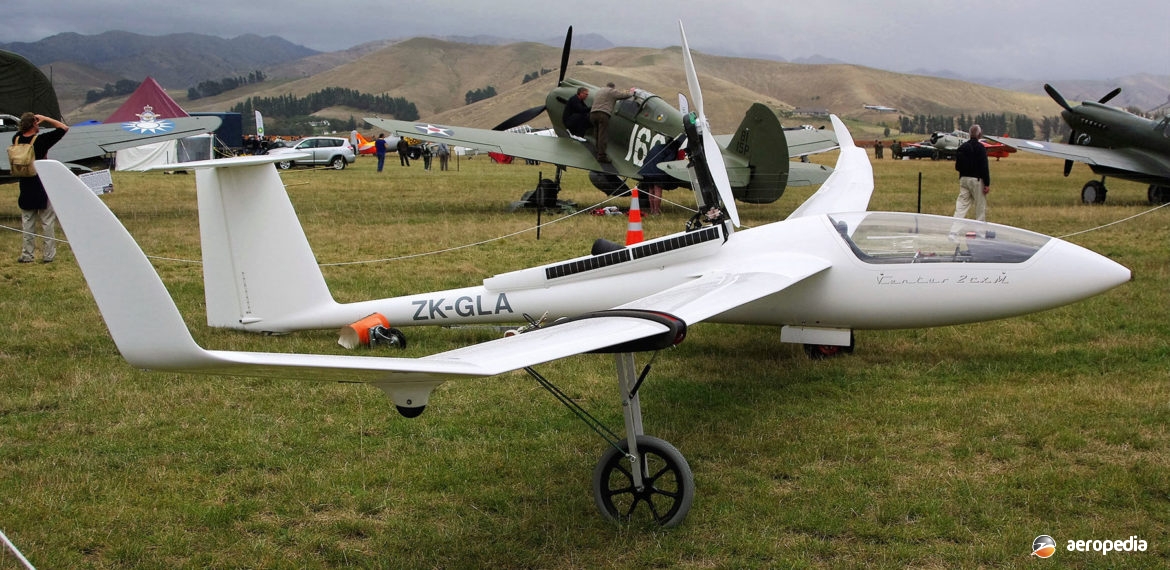Photograph:
Schempp-Hirth Ventus ZK-GLA (c/n 223) at Omaka, New Zealand (NZCIVAIR)
Country of origin:
Germany
Description:
Self-launched glider
Power Plant:
One 19.6 kw (26 hp) Solo 2350 two-cylinder, two-stroke, in-line air-cooled engine
Specifications:
- Wingspan: 15 m (49 ft 2 in)
- Length: 6.81 m (22 ft 3 in)
- Height: 1.3 m (4 ft 3 in)
- Wing area: 9.67 m² (104.10 sq ft)
- Max permitted speed: 270 km/h (168 mph)
- Empty weight: 235 kg (518 lb)
- Loaded weight: 525 kg (1,157 lb)
History:
The Ventus is a motorised glider produced by Schempp-Hirth in Germany. It was produced during the years 1980 to 1994 and was designed by Klaus Holighaus. It replaced the Mini-Nimbus on the production line. A total of 613 of the Ventus series was produced. First flight was made in 1980 and it was aimed at the 15 m (49.2 ft) market. It became popular following the reduction in cost of building components from carbon fibre reinforced plastic. These materials allowed thinner aerofoil sections and this permitted gliders to cruise at higher speeds than had previously been available for gliders built from wood and fabric.
The model 2bx followed the 2ax on the production line, the former having advantages and improvements in its flight characteristics, these being due to a combination of a lower drag from the horizontal and vertical stabilizer aerofoils developed by Prof L M Boermans, together with winglets developed at the Pennsylvania State University in the USA. The 2bx incorporated the fuselage of the Ventus 2c as the basis for a new fuselage and cockpit interior. The machine had a ballistic sailplane rescue system. The fuselage was produced in two sizes in order to meet the requirements of pilots of different heights, the Ventus A being for short pilots and the Ventus B having a longer and wider cockpit. The Ventus A and B had a complex flap / brake system whereas the Ventus C had conventional upper-surface air brakes separate from the trailing edge flaps. The Ventus won two World Gliding Championships in the 15 m (49.2 ft) class. Two models were fitted with engines, the Ventus B and CT having a retractable sustainer engine; whereas the Ventus CM had a retractable engine for self-launching.
A number of variants of the Ventus series have been produced, a 15 (49.2 ft) model complying with Racing Rules. Extended wing-tips were available to increase this to 16.6 m (54.4 ft). Powered models included the Ventus BT with a 15 m (49.2 ft) or 16.6 m wing (54.4 ft); the Ventus CT with a 15 m (49.2 ft) or 17.6 m (57.7 ft) wing; and the Ventus CM with a 15 m (49.2 ft) or 17.6 m (57.7 ft) wing.
Some 37 examples of the Ventus have been registered in Australia and the powered models, which included the 2CM and the 2CT include: VH-GEV (c/n 92); VH-GLR (c/n 42); VH-GRD (c/n 18-158); VH-GRG (c/n 17-155); VH-GVM (c/n 209); VH-IIK (c/n 37); VH-IKB (c/n 129); VH-KRJ (c/n 116); VH-PEO (c/n 174); VH-VCM (c/n 36); VH-VCX (c/n 146); VH-VMZ (c/n 222); VH-VTT c/n 98); VH-ZBW (c/n 43); VH-ZKT (c/n 99) and VH-ZVI (c/n 157).

